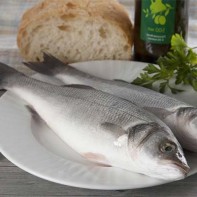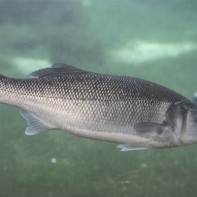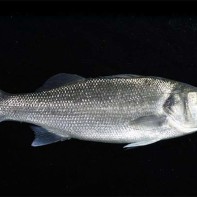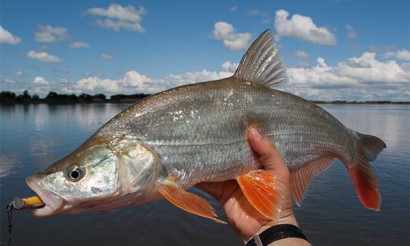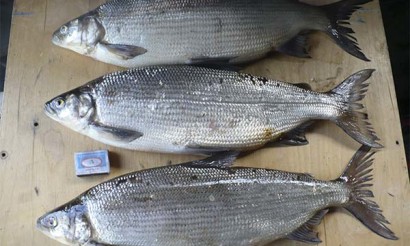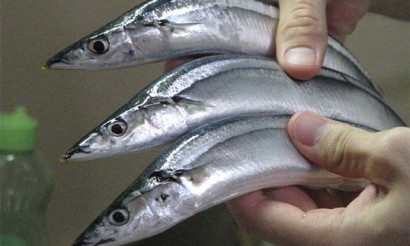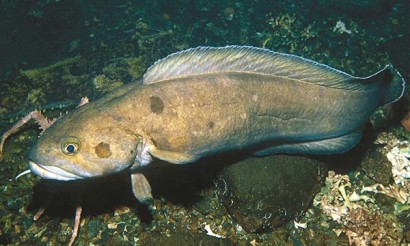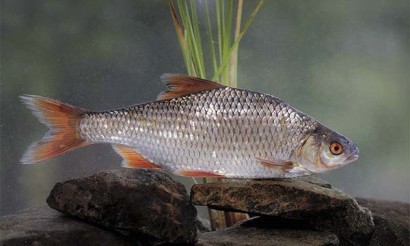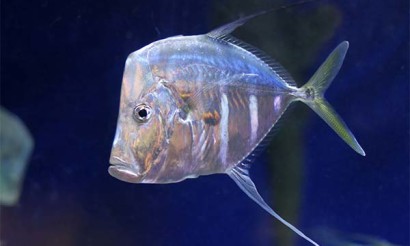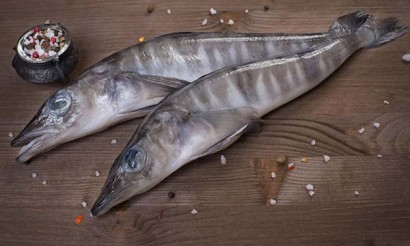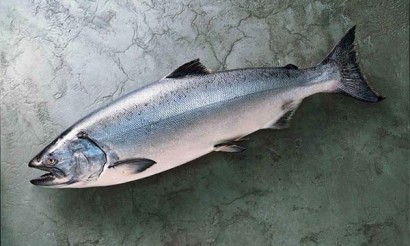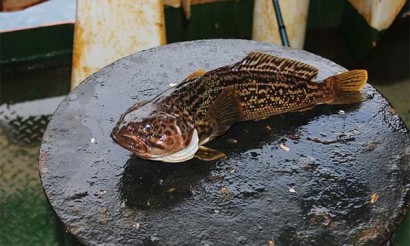Sea bass fish: description, useful properties and recipes for cooking
Delicacy fish, which is appreciated by gourmets and restaurateurs in many countries, is not only tasty, but also useful. Seabass, sea bass, spigola, sea pikeperch or sea wolf contains Omega-3 fatty acids, supports the nervous, cardiovascular, immune systems.
- Sea bass: what kind of fish it is, what it looks like and where it lives
- How it looks
- Where does it live
- What does it feed on?
- Spawning
- Types
- What is the difference between dorado and sea bass
- How to catch sea bass: when, where and on what?
- When to catch
- Where to catch
- What to catch
- Composition and calories
- What is sea bass good for?
- General benefits
- For women
- For men
- For Children
- In Pregnancy
- For breastfeeding
- When losing weight
- Harm and Contraindications
- How to choose and store
- Where to buy and how much costs
- How to peel and gut the fish
- How to cook sea bass: Recipes
- In the oven
- In the frying pan
- On the grill or barbecue
- Sea Bass Okra Recipe
- Q&A
- What does sea bass taste like?
- Fatty or not?
- Are there many bones?
- Can it be salted?
- What kind of wine do you drink with fish?
Sea bass: what kind of fish is it, how does it look and where does it live?
A species of representatives of the perch family of the Moron family has been scientifically named the common sea bass (Dicentrarchus labrax) since 1987. Fish of this species differ in size, coloration depending on habitat, food supply, age.
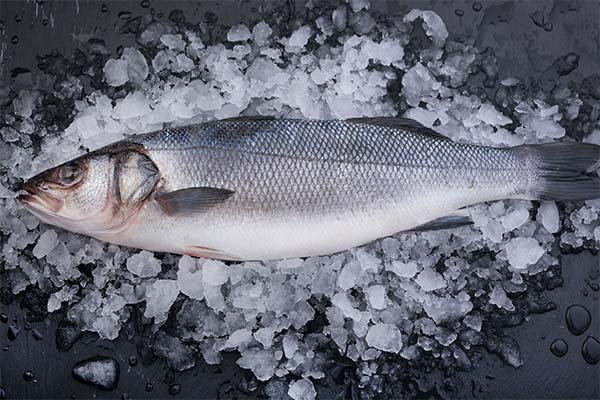
The largest sea bass caught in Atlantic coastal waters weighed 12 kg with a body length of 103 cm. More often commercial fishermen sell sea bass weighing 0.7-1.2 kg and 30-50 cm in length.
What does it look like?
The height of the elongated, slightly laterally compressed body is less than the length of the cone-shaped head with a large mouth. Coloration varies from silvery with darker tones on the back and lighter on the belly to black depending on the species. Artificially reared fish are uniformly colored in silver. Juveniles have dark spots scattered over their bodies, which disappear with age.
The body of the sea wolf is covered with ctenoid scales characteristic of higher bony fish. The scales have spines or teeth at the posterior edge. The fish's mouth is equipped with tufted teeth located on both jaws, tongue, and palate.
The back has two fins, the first of which consists of spiny rays, the second of soft. The tail is not bifurcated, but with a small notch in the center. The common laurel has a distinctive black spot on top of the gill cover.
Where does it live
The natural habitat of sea bass is the coastal waters of the Atlantic from Norway to West Africa. In smaller numbers, the fish occurs in the Black Sea, Mediterranean Sea and salt lakes. It briefly enters the estuaries of rivers.
Mobile juveniles lead a gregarious lifestyle, moving at different depths from the bottom to the surface layers of water. Mature fish prefer to feed alone.
Since the second half of the last century sea bass have been successfully farmed in fish farms in artificial pools or fenced off coastal areas. Italy, Spain, and France have succeeded more than other countries in breeding sea bass. The largest suppliers of wild fish to Russia are Greece and Turkey.
What does it eat?
In terms of food behavior, the sea bass is a predator that hunts at night. Its diet includes:
- crustaceans - shrimp, crabs;
- sea worms;
- mollusks - krill, squid, oysters;
- young fish.
Seabass preys from an ambush. It catches its prey with a sharp rush and swallows it whole. Use their powerful jaws to break the shells of crustaceans.
Spawning
Seabasses become sexually mature by age four at a body length of at least 32 cm in males and 42 cm in females. Sea bass spawn once a year in coastal waters with a temperature of +12 degrees. In the warmer Mediterranean and Black Sea, spawning begins in January and off the coast of Britain in March.
Females lay pelagic eggs 1.2 mm in diameter, making 3 or 4 clutches. When there is no current, the eggs sink to the bottom. Ichthyologists have calculated that the average fecundity of the fish is 200 thousand eggs per 1 kg of female weight.
Types
There are 2 species of sea bass - common and Chilean. The latter, called the Patagonian canine, is darker (from gray-brown to black with a blue cast) and more massive. All fins are equipped with spines, the snout is sharpened, and the mouth is larger than that of the common sea lion. The toothfish belongs to another family (Nototenidae) and lives off the coast of the western Atlantic, in the Gulf of Mexico at a depth of 50-4000 m. The water temperature is 11°C, which is favorable for life.
The area of distribution of common sea bass is the western part of the Atlantic coast. In contrast to the Chilean species, this fish is lighter and smaller, lives in warmer waters with a temperature of 18 degrees. In summer, it feeds in the territorial waters of Norway, goes to winter to the coast of Morocco and Senegal.
How it differs from dorado and sea bass
Despite the fact that the sea bass is called sea bass, the fish differ from each other in appearance and by scientific classification. Perch, of which there are more than 100 species in the genus, belong to the scorpine family. Most of them lead a near-bottom lifestyle and do not migrate long distances. A distinguishing feature is the presence of poisonous glands in the rays of the fins.
Dorado The spar family is called the golden spar because of the golden stripe along the forehead, which sea bass do not have.
Representatives of the sparrow with an oval, flattened body as well as sea bass with elongated body length has few bones, but the first, they are thicker and stronger. In addition to the body, the shape of the head differs. Dorado has a blunt head, sea bass has a cone-shaped head.
If it is easy to distinguish the undressed fish, the white fillet is almost impossible. Meat of both is interchangeable in recipes. Has the same energy value, taste.
How to catch sea bass: when, where and for what?
Sea bass is caught on an industrial scale by seine nets and bottom trawls. In Ukraine, the species is included in the Red Book, while in Ireland and England catching is limited. Amateur fishermen catch sea bass from the shore, boats all year round in two ways - by spinning and by fly fishing.
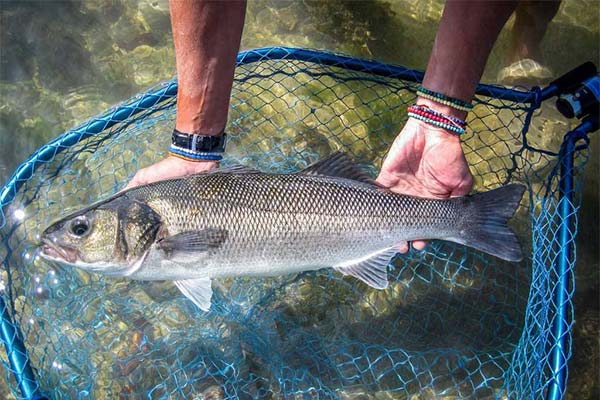
When to catch
Biting occurs more often at dusk, at night and at dawn. During this time, the fish are most active in feeding. Seabass is well caught after the tide and storms, when the waves nail the small fish to the shore. Catch should begin long before the tide goes out, because the fish move with it to the depths.
Where to catch
To catch the sea wolf choose:
- shallow water with a rocky bottom;
- sandbanks;
- breakwater areas;
- Seaports where ships throw overboard food scraps;
- piers, jetties;
- coastal rocks.
According to observations of experienced fishermen, bites are more active in windy weather.
What to catch
The choice of tackle depends on the method, place of fishing. For spinning fishing from the shore, rocks or pier choose a rod length of 3.5 m. Since sea bass fish are cautious and timid, you need a thin, fast sinking cord or fishing line with a breaking weight of 3-4 kg. Reel can be wineless or multiplier, but always with protection against salt.
When fishing from the beach in shallow water using surface lures, deep water sinking models work better. Seabass responds to wobblers, flat wobblers, poppers, artificial fish.
Bait color depends on the time of day. At dusk and at night, sea bass are caught on purple baits, at dawn and during the day - on white and silver. Early in the morning it is better to prefer blue, red, white. Start catching with small baits, gradually changing them to larger. Provodka should be intermittent, closer to the bottom.
The method of fishing for fly fishing suggests a single-handed rod 6-7 class, if the fish is not large. For trophy suit blanks of class 8-9 and a class above the cord. To rods pick up a large reel with a reliable braking system, protection from salt water and a line length of not less than two hundred meters.
As a bait use imitation fry, invertebrates, surface sliders, poppers, different models of streamers. When fishing at depth works better clouser.
Composition and calories
Sea bass meat is rich in proteins, cobalamin, vitamins D, PP, chromium, iodine, phosphorus. The fish contains unsaturated fatty acids Omega-3, which prevent diabetes.
The contents of 100 grams of sea bass edible portion of vitamins, minerals:
Vitamins:
- cobalamin - 0.003 mg;
- calciferol - 0,003 mg;
- nicotinic acid - 1,6 mg;
- Thiamine - 0.11 mg;
- pantothenic acid - 0.4 mg;
- riboflavin - 0.12 mg;
- pyridoxine - 0.13 mg;
- Tocopherol, 0.8 mg;
- A, 0.04 mg;
- folate - 0.008 mg;
- ascorbic acid, 1.4 mg.
Micronutrients:
- Cobalt, 0.03 mg;
- chromium - 0.06 mg;
- iodine - 0.06 mg;
- zinc - 0.002 mg;
- molybdenum - 0.004 mg
- iron - 0.001 mg; manganese - 0.001 mg;
- manganese, 0.001 mg.
Macronutrients:
- phosphorus - 220 mg;
- sulfur - 210 mg;
- magnesium - 60 mg;
- potassium - 300 mg;
- calcium - 120 mg;
- chlorine - 165 mg;
- sodium - 75 mg.
BWD of 100 g of the product - 18.2, 3.3, 0 g respectively. The energy value is 103 kcal.
How is sea bass good for you?
General benefits
Sea bass with high-quality protein, assimilated by 97%, Omega-3 fatty acids, rich vitamin-mineral complex has beneficial effects on the body:
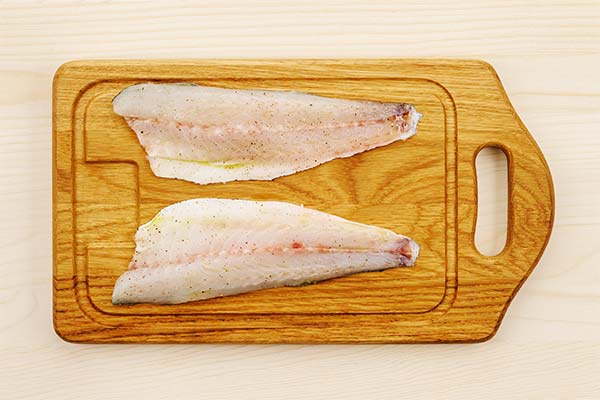
- Strengthens the immune system, resists infections.
- Participates in hematopoiesis.
- Increases the level of hemoglobin.
- Speeds up metabolic reactions.
- Prevents the development of leukopenia, anemia, and atherosclerosis.
- Mineralizes bones.
- Stabilizes hormonal background.
- Normalizes blood levels of glucose and cholesterol.
- Supports the function of the thyroid gland, heart, and organs of vision.
- Reduces stress on the nervous system, the damage from the effects of stress.
- Improves digestion.
- Flushes out toxic substances.
- Accelerates thinking, concentrates attention, improves memory.
- Prevents dementia, Alzheimer's and Parkinson's diseases.
- Inhibits the growth of cancer cells.
- Regulates blood pressure, electrolyte, water, acid balance.
- Suppresses chronic inflammation.
- Improves sleep patterns.
- Has an antioxidant effect, binds and removes free radicals.
- Improves nerve impulse conduction.
- Strengthens the vascular wall.
Inclusion of sea bass in the diet inhibits the development of diseases of the joints, spine. Fish recommended by nutritionists for patients with pancreatitis, gastritis.
For women
If there is a constant diet of fish, women reduce the intensity of symptoms during PMS, menopause. It slows down the process of thinning of bone tissue, leading to osteoporosis, stabilizes the psycho-emotional state.
Consumption of laurel meat supports the work of the small pelvis, prevents diseases of the mammary glands, reproductive organs. Improves skin condition, strengthens hair follicles, tooth enamel and nails.
For men
Calciferol in the fish increases testosterone levels, protein, fluorine, magnesium are responsible for stable erectile function, blood supply to the genitals. Zinc increases sperm motility.
Including sea bass in the menu:
- Supports heart, vascular health;
- Reduces the likelihood of strokes, heart attacks;
- Increases stress resistance, physical endurance.
Men who eat fish twice a week, are more productive and less likely to suffer from chronic fatigue.
For kids
Lean sea bass meat pediatricians are advised to include in the diet of children from nine months, starting with a teaspoon and increasing to 50 g by a year and a half.
The benefits of fish for the child:
- Supplies protein to the body;
- Forms the musculoskeletal system, prevents rickets;
- adjusts the metabolism:
- stimulates the work of the brain;
- Improves immune status, resistance to infectious diseases.
Laurel promotes growth, full mental, physical development of children.
In Pregnancy
In baked, boiled, stewed form sea bass is useful for pregnant women in all trimesters.
Easily digestible fish meat is a quality protein for building tissues, internal organs and systems of the child. The product helps in the formation of the skeleton due to the content of phosphorus, calcium, calciferol. B vitamins stimulate the synthesis of gray matter of the brain.
Micro, macro elements in the laurel participate in the development of hearing, vision, support the body of the future mother, experiencing increased stress. Pregnant women who eat 2-3 servings of fish a week, less tired by the end of the day. They have better sleep, mood swings disappear.
When breastfeeding
Seabass during lactation replenishes the loss of protein, calcium, iron and other useful minerals. Prevents the development of postpartum depression, instantly infused with energy.
In addition, fish meat regulates cholesterol levels, maintains heart health, youthful skin, fights insomnia.
For weight loss
Dietary product with low energy value nutritionists advise to include in the menu at excess weight.
Sea bass meat for weight loss:
- satiates for a long time;
- it is quickly digested;
- stimulates the synthesis of digestive enzymes;
- adjusts the lipid metabolism;
- Saturate weakened unbalanced diet body with vitamins, micro, macro elements.
To lose weight faster, eat sea bass boiled or steamed. The caloric value of fish increases by more than 2 times after frying or grilling.
Sea bass not only helps to quickly lose extra pounds, but also to keep the new weight for a long time, preserving health.
Harms and contraindications
The only absolute contraindication is an individual reaction to fish protein. You should consult your doctor if you have problems with your thyroid gland or liver.
Sea bass with expired or improperly stored harms the body. Artificially grown fish should be preferred to wild fish. Nutritional additives that are used in fish farms can cause allergies.
How to choose and store
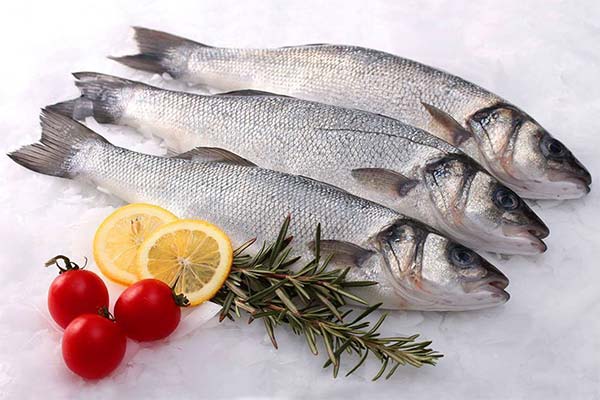
Chilled quality sea bass has no:
- extraneous odors,
- cloudy sunken eyes;
- Brown, dark red gills;
- Dents, spots, spills;
- loose belly.
Freshness of sea bass stored in a mini refrigerator on an ice pad is characterized by: elasticity, meat density, transparent, convex eyes, pink gills, absence of mechanical and disease-induced skin lesions.
The optimal storage temperature for chilled seabass is -2-0°. Under such conditions, fish does not lose its consumer properties up to 12 days. Nutritive value and taste of sea bass in the refrigerator is preserved for no more than three days. In the freezer frozen gutted carcasses do not spoil up to one year.
Where to buy and how much it costs
If previously sea bass meat could only be ordered at expensive restaurants, nowadays fish is purchased at specialized stores, fish departments of chain supermarkets, at selling online sites.
Artificially grown sea bass is sold at the price of 600-900 rubles, wild - 1400-1800 rubles.
How to clean and gut the fish
To clean and gut sea bass you will need a wooden cutting board, a sharp knife, containers under the meat, scraps.
Instructions for cutting fish:
- Trim the fins with kitchen scissors so you don't prick your fingers.
- To remove scales, place the fish head-first in a large cellophane bag. Holding the sea bass by its tail, run the blade of a knife or spoon with pressure over the body toward the head. The scales will come off and stay in the bag.
- Use the tip of the knife to flatten the belly from the anus to the head.
- Remove the viscera carefully, being careful not to damage the gallbladder.
- Scrape away the black film inside the belly.
- Remove the gills.
After cutting the sea bass, rinse with running water and dry with paper towels.
How to cook seabass fish very well: Recipes
Premium fish is boiled, steamed, pan-fried, barbecued, grilled, baked in the oven, stewed. Sea bass can be combined with mustard sauce, cumin, sage, mint, lime, rosemary, turmeric, black pepper, and white pepper. Tender fish is served with green beans, green peas, potatoes, rice, grilled vegetables, potato and vegetable salads, tomato and soy sauce.
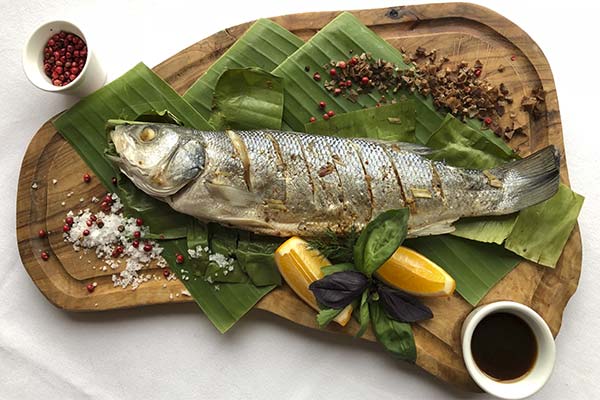
In the oven
To bake three seabasses weighing 350 g you will need:
- one lemon;
- Four garlic cloves;
- 60 grams each of soy sauce, vegetable oil;
- rosemary, salt, pepper to taste.
Method of preparation:
- Coat the cleaned, gutted carcasses on top and inside with marinade made of soy sauce, pressed garlic, oil, spices.
- Put the gutted fish into a bowl and pour lemon juice over it.
- After 20 minutes, place the sea bass on a greased baking sheet. Send it to bake in an oven heated to 200 degrees for half an hour.
Serve mashed potatoes, rice, baked vegetables - eggplants, cauliflower, carrots, young zucchini.
In a pan
To pan-fry sea bass deliciously:
- Make several transverse cuts on the sides at an angle. This is to help the fish cook faster.
- Season the outside and inside of the carcass with pepper and salt. Squeeze the juice of a lemon over it.
- After 15 minutes, heat a pan with refined oil.
- Roll seabass in flour, fry on both sides for 4-6 minutes until a delicious crust is formed.
Juicy, tender fish, cooked as a whole, served with your favorite side dish, salad with fresh vegetables, garnished with lemon slices.
Grilled or barbecued
The secret of tasty fish lies in a proper marinade and fast cooking, as seabass becomes dry when baked for a long time.
To prepare seabass with natural flavor and notes of spicy herbs, prepare:
- 50 ml of oil (olive oil is better);
- 2 garlic cloves;
- lemon;
- Two leaves of mint, sage;
- salt, white pepper.
How to grill or barbecue:
- Squeeze the juice from the lemon into a bowl. In the same place grate the zest on a fine grater. Season with salt and pepper.
- Chop sage, mint, pass garlic through the press.
- Combine all the ingredients. Stir in the oil. Cover the bowl with cling film and put it in the cold place.
- Remove scales from fish, remove gills, take out the insides without tearing up the stomach.
- Salt, sprinkle with lemon juice, skewer or place on a rack.
- Fry, brushing the sides periodically with the cooled marinade.
Serve sea bass cooked over charcoal or grilled with leftover sauce.
Sea Bass Ooch Recipe
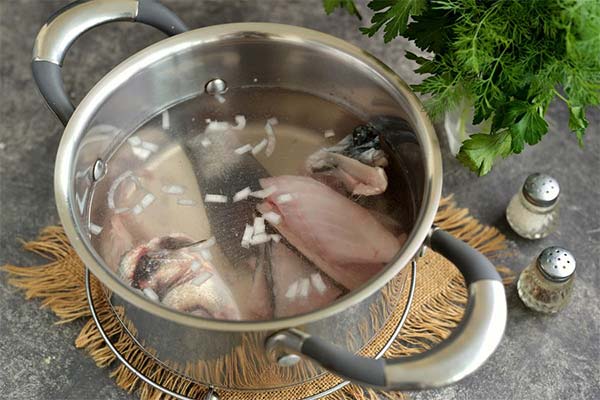
Ingredients for a classic fish soup from 0,5 kg of sea bass:
- 1 piece each of carrot, parsley root, celery root, onion;
- 1 liter of water;
- 2 bay leaves;
- A couple of sprigs of parsley;
- 50 g leeks;
- 1 tsp. salt;
- black pepper.
How to prepare:
- Clean fresh fish of scales, gut it, remove the gills.
- Cut off the fillets, rinse all parts of the fish. Put the flesh into the fridge.
- Coarsely chop onions, root vegetables.
- Lower the vegetables, the backbone with the head into a pan with water.
- Turn the stove on medium heat. Bring the fish soup to a boil, turn down the heat, remove the foam.
- After 30 minutes add bay leaves, peppers. Boil it for another half hour.
- Remove the vegetables and fish from the pot, strain the broth and pour it back.
- Put the container on the stove, salt the contents, put the fillets, boil for 5 minutes.
- Chop the boiled vegetables and add to the broth. In 2 minutes the dish will be ready.
When serving, the broth is poured on plates, add a piece of fillet, sprinkle with chopped parsley greens.
Q&A
Sea bass lovers are interested in the taste of the fish, whether it has many bones, how to cook it and what to serve it with.
What does sea bass taste like?
The meat has a neutral, slightly sweet taste. The flesh is tender but dense. Keeps its shape well when cooked in any way. The fishy smell is poorly pronounced.
Fatty or not?
Sea bass is a low-fat breed of fish. There is only 3.3 g of fat per 100 g of fillet. The dietary product is included in diets for weight loss.
Are there many bones?
A big plus of sea bass is that except for the backbone, it has almost no bones. This bonus makes it suitable for children's food.
Can it be salted?
Sea wolf can be salted just like any other saltwater fish.
What wine to drink with fish?
In order not to overpower the delicate taste of the delicacy, white wines from Bordeaux, Riesling, champagne brut and other noble drinks with low tartness are served with it.
If sea bass is properly selected and cooked, you can get a delicious nutritious dish with a zero glycemic index, a lot of useful properties.
«Important: All information on this site is provided solely for informational purposes. Consult a specialist before applying any recommendations. specialist before applying any recommendations. Neither the editors nor the authors shall be liable for any possible harm caused by materials."

